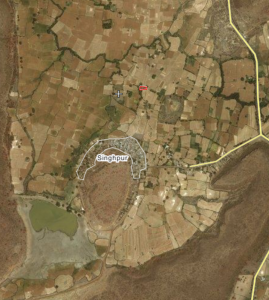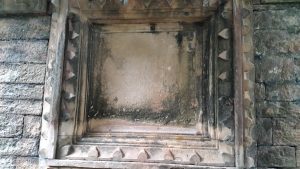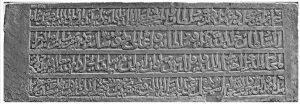Singhpur stepwell with an inscription of VS 1535/1479 CE

Singhpur (Ashoknagar अशोकनगर). Rājmatī stepwell (Wikimapia).

Singhpur stepwell inscription of VS 1535 (© Saarthak Singh).

Singhpur stepwell, damaged companion inscription (© Saarthak Singh).
Singhpur (Ashoknagar). Stepwell with inscriptions in mixed Sanskrit recording the construction of the stepwell by Rājamatī in VS 1535.
INIG1100 Budhi Chanderi Inscription of VS 1100
INIG1100 Budhi Chanderi (Guna). On a slab kept in the sculpture shed at Chanderi. Number of lines not given, nāgarī, Sanskrit. Records a praśasti of the Śaiva ācārya Prabodhaśiva, the disciple of another ascetic (name lost) who belonged to the lineage of the Śaiva ascetic Dharmaśambhu. Composed by Daśaratha.
INIG1086 Chanderi Inscription of VS 1086
INIG1086 …śudi 11 Chanderi (Guna). On the pedestal of a broken image near the rest house in the fort. Number of lines not given, nāgarī, Sanskrit. Appears to record the making of the image; mentions a certain sha(kha)trī Ratanadeva. A Garuḍa figure is carved in the middle of the inscription.
INIG964 Budhi Chanderi Inscription of VS 964
INIG964 Jyaiṣṭha śu… Budhi Chanderi (Guna). On a stone slab (stored in sculpture shed at Chanderi). Number of lines not given, early nāgarī, local dialect. Mentions the names of a number of persons such as Chīchu, Kesava, Rāula, etc.
INIG1555 Rakhetra rock-cut inscription of VS 1555
INIG1555 Rakhterā (रखतेरा or Rakhetrā, Ashoknagar, Madhya Pradesh). Rock-cut inscription of VS 1555 above foot prints near a large rock-cut image of Ādinātha at the site known as Bhiyāṃdāṃt. Working transcription (01/2019)
[line 1] saṃvat 1555 varṣe phāguṇa-sudi 2 śukra-vāsare revatī-nakṣatre mālavaka-deśe kṣa-
[line 2] laj[ī]-vaṃśe suritrāṇa gyāsu[d]īna-vijaya-rāj[ye]…
[line 3] śrī vinaya [?śeraṣā-pratāpe śrī rājamaṇe śrī malayacaṃdasūri ś[iṣya]° u[pādhyāya]° [ke]śarva-
[line 4] (ddha) śi[ṣya]° u[pādhyāya]° śrī mānikasuṃdara śi[ṣya]° u[pādhyāya]° śrī viśālarājasya pādukā kā-
[line 5] (rāvitā) śi[ṣya]° munirājena śreyas tu[leṇa] ra(ṇaśvata) 1111 ii ra | (sākṣāt) ||
Chanderi Stone Slab of ‘Alā’ al-Dīn Khaljī
Chanderi Inscription of ‘Ala’ al-Din Khalji

Chanderi Stone of ‘Alā’ al-Dīn Khaljī, recording the completion of a mosque in Chanderi during the governorship of Amīr al-Umarā’, Ikhtiyār al-Dawla wa al-Dīn Tamur Sulṭānī by Ismā‘īl, son of ‘Abd al-Salām, entitled Wajīh-i Najīb, the muḥarrir of the district (khiṭṭa) of Kol (Aligarh) during the reign of ‘Alā’ al-Dunyā wa al-Dīn Abu al-Muẓaffar Muḥammad Shāh (i.e. ‘Alā’ al-Dīn Khaljī, popularly known as Alauddin Khalji, d. 1316 AD).
